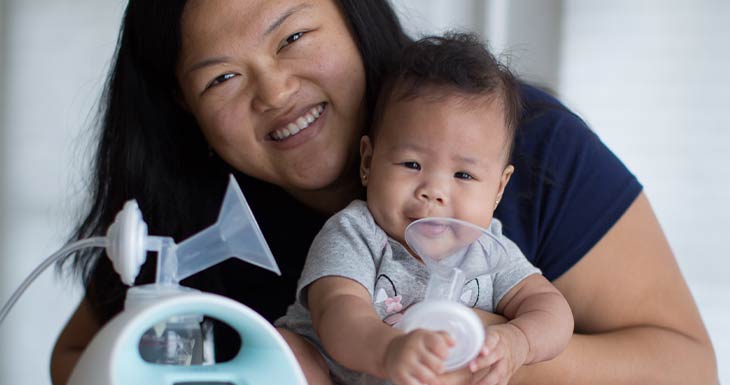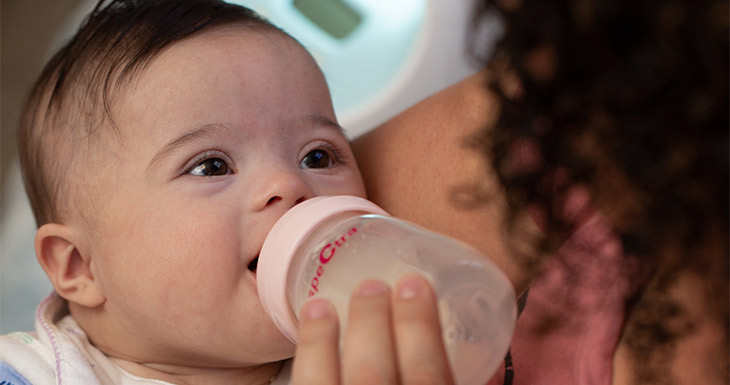
By Jacque Ordner BSN, RN, IBCLC, RLC
One of the biggest concerns and struggles of parenting young children is SLEEP! Sleep deprived parents of newborns and infants have undoubtedly been asked, “Is she sleeping through the night yet?” Many of us have received advice from well-meaning friends and family regarding how much our babies “should” be sleeping and how to get them to do so. But what does research tell us? What is developmentally normal for babies? What about the countless methods and internet-based courses focused on getting babies to sleep? Read on for some important truths about newborn and infant sleep.
First things first, it is completely normal for your breastfed newborn to wake and eat every few hours around the clock. Babies’ stomachs are small, and they need to feed frequently in order to consume adequate calories and nutrition. For most breast milk fed babies, this translates to 8-12 feedings in 24 hours. It’s true that most newborns spend 15-18 hours sleeping each day, but that sleep comes in small chunks spread across 24 hours. Frequent waking is also a protective mechanism that is designed to reduce the risk of SIDS! Check this link out for additional info https://www.ncbi.nlm.nih.gov/pubmed/9346985 .
Scheduling or restricting feeds can be dangerous! Any sleep training method, sleep course, sleep product, or sleep coach that that advises limiting feeds, scheduling feeds, or only feeding during certain “windows” for babies is NOT BREASTFEEDING FRIENDLY despite any claims to the contrary. Babies should be breastfed on demand rather than on a schedule or within specific windows. Our IBCLCs are aware of several cases where scheduling and restricting feeds has led to poor infant weight gain and significant milk supply issues. Feeding on demand is the best way to ensure your baby is getting enough milk and to encourage your own milk production. In fact, studies show that babies can take as much as 20% of their nutrition requirements during nighttime feeds.
It is a myth that babies regularly sleep through the night at just a few months old. In fact, most babies do not sleep through the night until closer to age one or beyond! Sleep is a developmental skill. Babies cannot learn to fall asleep on their own until they are developmentally ready to do so, and they aren’t all ready at the same age. It’s important to let go of unrealistic expectations regarding sleep. Though unicorn babies, who sleep all night at 4 weeks old, do exist, they are the exception, not the norm.
We can encourage healthy sleep behavior in our babies. Though sleep is developmental, we can still create an environment that fosters healthy habits related to sleep. Babies are often tired, but need help falling asleep. Learning your baby’s sleep cues is a first step to helping him get off to dreamland before becoming overtired and cranky. Common sleep cues include rubbing the eyes, yawning, drooping eyelids, redness around the eyes, smiling less, vocalizing less, exhibiting a weaker than normal suck, and turning away from toys or people. Picking up on these cues and responding in a way that helps our babies go to sleep is key! Experts also tell us that encouraging adequate daytime naps positively contributes to more consistent night–time sleep. Breastfeeding to sleep is normal, and absolutely ok! Your baby sees you and breastfeeding as their greatest source of comfort and safety, so it is only natural that they would desire that comfort and safety when trying to fall asleep. Many breastfeeding mothers follow the Safe Sleep Seven to help their babies feel safe and secure all night long. Your child will eventually be developmentally ready to learn to fall asleep all on their own even if they need your help right now. As your baby gets older, you can start to transition to more independent sleep behavior slowly.
Will cutting out nighttime breastfeeds help my toddler sleep? It’s important to note that babies often require night–time feedings well beyond the newborn stage. It’s also important to note that cutting out night-time breastfeeds for older babies and toddlers needs to be approached on a very individual basis with special consideration to the child’s overall intake. It is not uncommon for older babies and toddlers to reduce night-time feedings if their daytime caloric intake simultaneously increases. Many parents find that night-time weaning is often easier when their child is closer to 18 months of age because they are capable of communicating and understanding the negotiation surrounding the weaning process. There is evidence that reducing night-time feeds contributes to less night-time waking for toddlers. Keep in mind that hunger is not the only reason that babies and toddlers wake at night! When made to feel safe, secure, and comforted older babies and toddlers can learn to get themselves back to sleep without parental intervention.
Infant sleep problems are a common concern among parents, but knowing what is normal can help put your mind at ease!
Our team of International Board Certified Lactation Consultants is happy to discuss newborn, infant, and toddler sleep as it relates to breastfeeding and pumping. Click here to schedule a consultation.
Sources:
Burnham, M., Goodlin-Jones, B., Gaylor, E., & Anders, T. (2002, September). Nighttime sleep-wake patterns and self-soothing from birth to one year of age: A longitudinal intervention study. Retrieved May 18, 2020, from https://www.ncbi.nlm.nih.gov/pmc/articles/PMC1201415/
McKenna, J., & McDade, T. (2005, June). Why babies should never sleep alone: A review of the co-sleeping controversy in relation to SIDS, bedsharing and breast feeding. Retrieved May 18, 2020, from https://www.ncbi.nlm.nih.gov/pubmed/15911459
Kent, J., Mitoulas, L., Cregan, M., Ramsay, D., Doherty, D., & Hartmann, P. (2006, March). Volume and frequency of breastfeedings and fat content of breast milk throughout the day. Retrieved May 18, 2020, from https://www.ncbi.nlm.nih.gov/pubmed/16510619
Middlemiss, W., Granger, D., Goldberg, W., & Nathans, L. (2012, April). Asynchrony of mother-infant hypothalamic-pituitary-adrenal axis activity following extinction of infant crying responses induced during the transition to sleep. Retrieved May 18, 2020, from https://www.ncbi.nlm.nih.gov/pubmed/21945361












